Final report for LNC21-450
Project Information
Problem Addressed and Solution Pursued
The Nebraska Sandhills region is one of the largest (20,179 miles2), intact native temperature grasslands remaining in the world. Sandhills grasslands are used primarily for beef cattle production, but these ecosystems also provide important wildlife and plant species habitat, wetlands and water infiltration for recharge of the Great Plains aquifer, and other ecosystem services such as recreation. Vegetation management typically includes a combination of grazing strategies, mechanical and chemical control of invasive plants, and, less frequently, prescribed fire. Tradeoffs that occur among competing ecosystem services (e.g., soil health, cattle weight gain, economic return, wildlife diversity) and disservices (e.g., invasive species, low plant diversity, compromised soils) must be evaluated and quantified when making management decisions that have consequences for sustaining livelihoods.
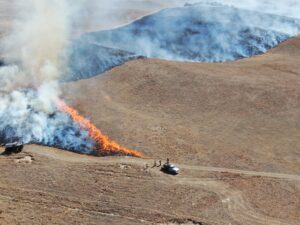
The collaborative adaptive management (CAM) project at Barta Brothers Ranch evaluates alternative, stakeholder-designed approaches to grassland management in the Sandhills and surrounding north-central Great Plains. CAM is often described simply as learning by doing or learning through management, which is true. However, CAM is more than simple trial-and-error; it involves strategically targeting uncertainties through experimentation and learning and then adjusting management accordingly. Simply put, CAM is about managing together, learning together, and putting that learning into practice over time.
At the outset, it is critical to define the problem being addressed and objectives of the CAM process. Initial meetings with the CAM Project Team (ranchers, land managers, researchers) broadly identified management of invasive species, enhancing livestock performance, and managing for heterogeneity and multifunctionality, or multiple ecosystem services on the same land area, as key problems/uncertainties and primary objectives for the research. Testing of management approaches for halting or reversing encroachment of eastern redcedar in the context of livestock production was identified as a particular uncertainty. A patch-burn grazing system was recommended as a management practice that could address these areas of concern. A patch-burn grazing system was implemented alongside a deferred rotational grazing system (status quo) over four grazing seasons (2022 - 2025) and ecological, animal, and economic outcomes were monitored and compared over time. Participants met at least semi-annually for field tours, to discuss monitoring outcomes in relation to key uncertainties, and to make any needed management approach adjustments.
Research Approach, Educational Approach, and Learning Outcomes
Utilizing the adaptive management framework, researchers established protocols to monitor and compare outcomes in woody vegetation, herbaceous vegetation, livestock, soil, and social learning among stakeholders before, during, and after a set of four grazing seasons in a patch-burn grazing system and a deferred rotational grazing system. In the springs of 2022, 2023, and 2024, through cooperation among stakeholders in the region, Barta Brothers Ranch completed prescribed burns in a series of 160-acre pastures within a four-pasture system. By opening gates between pastures, cattle were allowed to openly graze all four pastures in the patch-burn system (i.e., season-long continuous grazing), while cattle in the deferred rotational grazing system were rotated among each of the four pastures in each grazing season. In 2025, it was infeasible to implement prescribed fire due to dry and windy conditions and a burn ban; therefore an early stocking option was implemented in the pasture instead of burning, followed by continuous grazing in all four pastures, with gates between pastures open.
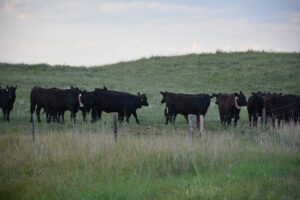
Each year, animals (spayed heifers) were put out to pasture in mid-May and removed in mid-September. Stocking rates (.62 AUMs/acre) reflected real-world conditions and were held constant throughout the grazing seasons despite variable conditions, including periods of above-average precipitation and regional drought. As a control, a similarly stocked four-pasture deferred rotational system was also established at Barta Brothers Ranch. Within each pasture, animals were weighed three times during the grazing season with the movements of some heifers (n=8) tracked via GPS collars and their diets monitored via fecal DNA, microhistology, and field surveys. Ecological variables compared between the patch-burn grazing and deferred rotational grazing system included plant community composition and structure, eastern redcedar mortality, bird community composition, soil nutrient levels, and soil erosion rates.
Learning outcomes for participants in the CAM process involve articulation of four forms of knowledge: CAM-reinforced, CAM-amended, CAM-generated, and CAM-attainable. Semi-annual on-ranch meetings, along with Zoom/phone and email communication, took place each year. This active engagement among stakeholders is foundational to the CAM approach. Through the co-production of science, shared learning and trust are fostered among the participants in the CAM research project at Barta Brothers Ranch. An online survey and two group mental modeling activities--one in early 2022 and one in late 2025--captured participant perceptions of the alternative rangeland management approaches. At the conclusion of the 2021 - 2025 CAM iteration, participants articulated: 1) things they knew prior to CAM, and still know (CAM-reinforced knowledge); 2) things they thought they knew prior to CAM, but have amended (CAM-amended knowledge); 3) things they didn't know prior to CAM, and learned through it (CAM-generated knowledge); and 4) things they still want to know (CAM-attainable knowledge).
Key Research Conclusions
- Cattle in the patch-burn system had better performance than cattle in the deferred rotational grazing system in each of the four studies years, with 22-31% greater average daily gains.
- Cattle in the patch-burn system brought better economic returns in each of the four years, with an average of $86-$138 more per head at the sale barn.
- Cattle selected recently burned patches over unburned patches early in the grazing season and that as the grazing season progressed, cattle increasingly selected the unburned pastures, until there was no effect of burning on cattle selection by August of each year.
- Within burned pastures, cattle were more likely to use open slopes and uplands than in unburned pastures.
- In 2024, we found 72% overall eastern redcedar mortality across 1,160 trees in a pasture within the patch-burn grazing system, with greater counts and mortality rates of smaller trees.
- In 2022–2024, we found that by August of each year, there were no effects of prescribed fire on vegetation productivity.
- We found no substantial differences in erosion between burned and unburned pastures, with both experiencing relatively small amounts of erosion/deposition (1 – 3 centimeters) and neither demonstrating an effect across entire pastures in the year of treatment or subsequent years.
- Canopeo-derived proportion of green pixel estimates provide reasonable estimates of total aboveground biomass in Sandhills ecosystems when sampling in the months of June and August.
- Following removal (mulching) of established eastern redcedar stands, initial results indicate high variability in species composition among the mulched plots and high proportions of annual plant species, compared to reference grassland sites.
Stakeholder Adoption Actions
Stakeholders articulated four forms of knowledge useful for informing management decisions moving forward--highlights of which from the November 2025 on-ranch meeting are presented below.
CAM-Reinforced Knowledge Highlights
- Prescribed fire is effective at controlling and reducing eastern redcedar encroachment in Sandhills ecosystems.
- Cattle were attracted to recently burned grassland patches.
- Prescribed fire increased forage nutritional quality.
- Patch-burn grazing increases grassland heterogeneity.
- Sandhills ecosystems were resilient to the linked prescribed fire and grazing disturbance.
- Patch-burn grazing is a workable and effective management system in the Nebraska Sandhills.
CAM-Amended Knowledge Highlights
- Forage production was more stable after fire and grazing than anticipated.
- Warm-season grasses remained more productive under patch-burn grazing then expected.
- Plant diversity and total production varied more than expected following prescribed fire.
- Vegetation in burned and grazed pastures recovered more quickly then expected.
- Cattle attraction to burned patches lasted longer then expected.
- Cattle average daily weight gains in the patch-burn system exceeded expectations.
- Grazing immediately after prescribed fire is more feasible and less risky than initially perceived.
- Eastern redcedar seedlings and resprouts appeared more quickly post-fire than expected.
CAM-Contributed Knowledge Highlights
- The strength of the fire-grazing interaction is stronger than previously documented in Sandhills landscapes.
- The combined effect of fire, grazing, and drought requires roughly two years of recovery under adequate precipitation.
- Cattle utilization of little bluestem was greater than assumed.
- Yearling cattle displayed strong gains in the patch-burn system under drought.
- Cattle effectively locate open gates and move effectively among pastures in the patch-burn system.
- Cattle responses to shifting forage availability was clear and quantifiable.
- Mulching large cedar stands has important ecological and operational tradeoffs.
- There was no substantial erosion in early-burned pastures.
CAM-Attainable Knowledge Highlights (continuing questions)
- Is prescribed fire cost effective and ecologically beneficial in areas without current woody plant encroachment?
- What is the optimal fire return interval for Nebraska Sandhills ecosystems under average conditions?
- What is the best alternative timing for fire if spring weather conditions prevent burning?
- How does grazing deferment length before burning (full, partial, or seasonal rest) affect eastern redcedar mortality?
- Can burning only slopes or certain topographic positions improve cost-effectiveness?
- When should cattle be turned out into grazed areas and how much ungrazed area should remain within a patch-burn grazing system?
- What are the effects of grazing burned patches during the cattle breeding season, particularly on cow breed-back?
- How do different livestock classes (cows, yearlings, small ruminants) respond to fire-altered forage?
- Do high-density grazing systems offer consistent benefits following fire?
- What are the effects of weather variability on plant biomass and functional group cover responses in a patch-burn grazing system?
- How does the timing of fire influence C3 versus C4 species composition over time?
- What are the responses of less-studied species (e.g., leadplant, roses, yucca, poison ivy) under patch-burn grazing?
- What are warm-season grass recovery rates under patch-burn grazing?
- Over the long term, how do forage production and animal performance compare between fire/rest and patch-burn grazing systems?
- What are soil health, carbon, and organic matter responses under repeated fire-grazing cycles?
- What is the applicability of patch-burn grazing further west in the Sandhills, where it is drier and dunes are larger/steeper?
- What are the economic implications of adopting long-term (10-year) prescribed fire plans?
- What are the economic outcomes of incorporating small ruminants into cattle-dominated systems?
- Is post-fire grazing deferment worth the lost grazing days?
- What is the feasibility of dual-use systems (haying and grazing) in burned pastures?
- What are opportunities to gain fire-driven cattle performance benefits without adopting full patch-burn grazing?
- What are the long-term ecosystem service outcomes under fire-grazing systems?
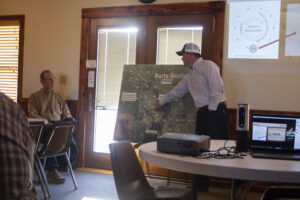
CAM requires stakeholder involvement from inception to completion. In this project, we: 1) Established a CAM program in the Sandhills to identify management challenges and goals; 2) Established Barta Brothers Ranch (BBR), a university-owned ranch, as a location for learning-by-management experiments, where stakeholders voice and test management hypotheses in an environment that does not affect their livelihoods; 3) Compared alternative, stakeholder-identified management approaches and evaluated their effects; 4) Monitored four forms of CAM-related stakeholder knowledge; and 5) Evaluated progress, success and uptake of CAM for rangelands.
The Nebraska Sandhills is one of the world's largest and most intact remaining temperate grasslands. Sandhills grasslands provide a variety of ecosystem goods and services, including beef cattle production, wildlife habitat, wetlands, water infiltration for recharge of the Great Plains aquifer, recreation, and support of livelihoods. Sandhills grasslands are carefully managed, often through combinations of cattle grazing strategies, mechanical and chemical control of invasive plants, and, less frequently, prescribed fire. Tradeoffs that occur among competing ecosystem services (e.g., soil health, cattle weight gain, economic return, wildlife diversity) and disservices (e.g., invasive species, low plant diversity, compromised soils) must be evaluated and quantified when making management decisions that have consequences for sustaining livelihoods.
Rangelands of the Nebraska Sandhills and surrounding Great Plains are increasingly impacted by woody plant encroachment. Land managers have uncertainties about the effectiveness of different management approaches for controlling woody plants and their ecological, economic, and social outcomes related to livestock, soils, ecosystems, landscape heterogeneity, and manager perceptions. It is possible to test new management approaches, but there are risks, uncertainties, and tradeoffs associated when it involves managing on one's own land.
In 2020, the University of Nebraska-Lincoln launched a collaborative adaptive management (CAM) project at Barta Brothers Ranch to address risks and uncertainties related to grassland management in the Sandhills. This project focuses on evaluating stakeholder-designed management plans in a collaborative research setting. This emphasis on co-producing science ensures CAM reflects real-world ranching conditions of the Sandhills and the North-Central Great Plains. This publication highlights results from years 1 - 4 of management treatment implementation (2022-2025 grazing seasons).
Cooperators
Research
Patch-burn grazing systems can increase livestock performance and rancher profitability while minimizing tradeoffs to other desired functions of the landscape.

Adaptive Management Framework
The foundation of the CAM Project at Barta Brothers Ranch comes from its linkage to the adaptive management framework. Adaptive management is an iterative process with aims to increase understanding of a system through a structured decision-making process. This includes: 1) defining the problem, 2) identifying objectives, 3) formulating evaluation criteria, estimating outcomes, 4) evaluating trade-offs, 5) deciding on actions to be taken, 6) implementing the action plan, 7) monitoring system behavior, 8) evaluating management outcomes, and 9) adjusting management.
Monitoring
The CAM Project Team continues to refine what and how to monitor, and to develop expectations of responses to stakeholder-implemented management. Since management treatments were first deployed in 2022, CAM members voted to maintain data collection as described below. Since that time, additional questions regarding rates of eastern redcedar re-encroachment after different treatments were posed by stakeholders and are being addressed through additional monitoring activities and a dissertation (J. Harvey), as are stakeholder questions about differences in post-fire surface temperature between burned and unburned areas.
Eastern redcedar mortality
Beginning in the summer of 2024, to quantify the effectiveness of prescribed for managing eastern redcedar in a patch-burn grazing management approach in Sandhills ecosystems, without deferring grazing, we conducted a census of eastern redcedar mortality in Pasture N-8, which as burned in April 2024. To assess tree mortality by size class, each tree was classified as dead or alive and assigned to one of the following height classes: < 1 foot, 1 - 2 ft, 2 - 3 ft, and > 3 ft.
Herbaceous vegetation
Vegetation data has been collected each year, including the year prior to application of treatments, through several different techniques, in pastures managed with patch-burn grazing and deferred rotational grazing. Vegetation variables monitored include plant species composition, aboveground biomass production, and structure. Collectively, these datasets are useful for comparing plant community responses under the alternative management approaches.
From 2021 - 2025, plant community species composition, structure, and dry weight rank was assessed using a 40 by 40 cm monitoring frame placed at multiple locations in pastures with different management approaches. Trained technicians located multiple monitoring points based on ecological site, topography, and aspect and recorded all rooted plant species within each monitoring frame placement. These data were used to quantify species richness, species frequency of occurrence and diversity, height, spatial variability of plant groupings, and relative importance of species across the locations and management alternatives. Methodological details can be found in Nolan Sipe's M.S. Thesis. Plant species composition data was also collected through Catherine Chan's Ph.D. research in 2023 and 2024. Under this approach, plant communities were sampled along 100-m transects in multiple dune complexes and positions within the patch-burn grazing system and deferred rotational grazing system. Transects were sampled twice across the growing season--once at peak C3 plant growth and once at peak C4 plant growth. Vegetation diversity indices derived from Catherine's transect data is also being compared to spectral diversity indices derived from hyperspectral remote sensing imagery in Catherine's dissertation research. Plant community composition and structure were monitored by trained technicians in 2025.
We leveraged and adapted long-term on-ranch biomass monitoring to compare vegetation productivity responses between the patch-burn grazing system and the deferred rotational grazing system. In this approach, multiple grazing exclosures were placed throughout the study pastures and annual net primary plant production was collected at two points during the growing season--C3 (cool season) peak standing crop and C4 (warm season) peak standing crop--by clipping all plant material at ground level, separating by functional plant group, drying to a consistent weight, and recording weights. We also conducted forage nutrient analysis to compare forage quality between the patch-burn system and the deferred rotational grazing system.
Remote sensing and landcover
At broader scales, remote sensing technology is being utilized to evaluate productivity, heterogeneity (i.e., diversity), and thermal responses across Barta Brothers Ranch. Specifically, the goal of this research is to explore relationships between field-based vegetation diversity and remotely sensed spectral diversity, as mediated by topography and rangeland management. In 2022 and 2023, hyperspectral and thermal airborne imagery were collected in mid-July for pastures in the patch-burn grazing system and surrounding areas. In 2024, the same data was collected twice in the growing season--once at peak C3 plant growth in June and once at peak C4 plant growth in August and were aligned with Catherine Chan's field vegetation surveys. At smaller scales, we are using proximal remote sensing (i.e., cell phone camera) the the Canopeo App for real-time biomass sampling through Hannah Allen's M.S. thesis research.
In addition to airborne remote sensing, we are using landcover data--specifically functional percent cover and biomass--from the Rangeland Analysis Platform (rangelands.app) to compare vegetation responses among pastures and between the patch-burn grazing and deferred rotational grazing treatments. Percent cover values are available in an online user interface, for download, and on Google Earth Engine (Gorelick et al. 2017) annually at 30-meter grain, whereas biomass is available annually or over 16-day intervals at 30-meter grain. Additional remote sensing products for early identification and tracking of vegetation state-transitions at multiple scales (state-transition screening, Uden et al. 2019) are being used to monitor woody plant encroachment at larger scales.
Grassland birds
For multiple pastures within both the patch-burn system and deferred rotational grazing system, we established 24 plots in a grid with sampling points spaced 250 m apart. To measure songbird abundance and composition, we conducted 150-m fixed-radius point counts three times at each point in each year from 2021 - 2025. At each point, an observer recorded all birds seen or heard for 6 minutes and the estimated distance from the observer to the bird. Species, sex, and behavior (observed singing, observed calling, heard singing, heard calling, observed only) of the bird were recorded. Additional methodological details are included in Nolan Sipe's M.S. thesis. In 2024 and 2025, avian point counts were conducted by trained technicians.
Livestock production and behavior
To compare livestock responses between the patch-burn grazing system and deferred rotational grazing system, we monitored cattle weights, movements, and diets. From 2022 - 2025, yearling heifer weights were collected at the beginning (prior to turn out on study pastures), middle, and end (conclusion of the grazing period) of each grazing season. Similarly, GPS tracking collars were placed on a portion of the study animals to evaluate shifts in cattle grazing behavior (i.e., grazing and resting times) and grazing distribution (i.e., where animals are grazing) in the study pastures from 2022 - 2025. Finally, in 2024 and 2025, animal diets were monitored through two methods that utilize fecal samples to identify plant species in cattle diets--fecal DNA analysis and microhistology--as well as observations of plant species utilization along transects at randomly generated points within pastures under the patch-burn grazing system and deferred rotational grazing system. The fecal DNA, microhistology, and plant species utilization monitoring and analysis is being conducted through Hannah Allen's M.S. thesis research.
Soil erosion and health
To compare soil erosion rates between burned and unburned portions of the patch-burn system, we established grids of erosion pins across (n=38) burned and unburned/control pastures. Initial pin aboveground heights are recorded and periodically remeasured throughout the grazing season. The difference in these measurements is the amount of erosion or deposition that had occurred at that pin location.
To monitor soil health, each year, soil samples are collected across multiple dune complexes and dune positions in burned and unburned (control) pastures before and after prescribed fire. Samples were collected at 0-20 cm depth at 1-m intervals along a 7-m transect on each dune position. Samples of each transect were aggregated, air dried and analyzed for available P (Mehlich III), soil organic matter (loss on ignition), total N, ammonium, and nitrate. Analysis of soil samples will provide data for comparing the patch-burn and deferred rotation systems influences on soil N, C, and P.
Ecosystem restoration and recovery
To monitor the recovery of Nebraska Sandhills grassland plant communities following removal of eastern redcedar windbreaks, in October 2024, three mature 0.3-hectare eastern redcedar windbreaks were mulched with an excavator, fencing was constructed around mulched sites, and vegetation surveys were conducted in mulched and reference grassland sites to test for differences in plant community composition and cover over time. This monitoring is being conducted through Jacob Harvey's Ph.D. research.
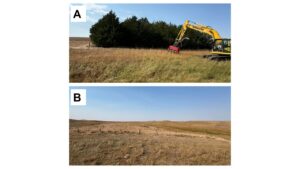
Stakeholder perceptions
To gauge stakeholder decision-making and perceptions of the CAM process, we deployed an online survey in Spring 2024. Similarly, to understand stakeholder perceptions of conventional and new rangeland management approaches, we conducted mental modeling activities at the 2022 and 2025 stakeholder meetings.
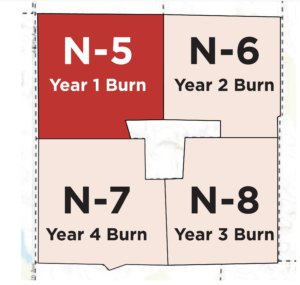
Despite several periods of challenging fire weather and drought conditions, the first three years of the CAM project were implemented as planned, with a patch-burn grazing system compared to a deferred rotational grazing system. Each year, one ~150 acre pasture was burned followed by continuous, open grazing of yearling spayed heifers. In March 2022, Pasture N-5 was burned followed by Pasture N-6 in May 2023 and Pasture N-8 in April 2024. Pasture N-7 was scheduled to be burned in 2025; however, persistent dry and windy weather conditions, along with a burn ban, made implementing prescribed fire infeasible. We adapted by substituting early grazing for prescribed fire in the pasture scheduled to be burned (N-7).

Heifers were stocked at similar rates (0.6 AUMs/acre) in each year. To monitor outcomes related to key questions and adjust management accordingly, researchers monitored and evaluated a host of vegetation, avian, livestock, and soil variables. Below are results from years 1 - 4 of the study (2022 - 2025), along with discussions of the research.
Eastern redcedar mortality
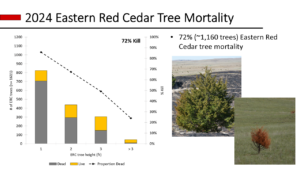
Following the 2024 prescribed burn in Pasture N-8, we observed 72% mortality across 1,611 eastern redcedar trees, with the proportion of dead trees decreasing markedly with increasing tree height. This finding echoes those of multiple other studies that report significantly greater eastern redcedar morality at smaller tree size classes. It is notable that the 2024 prescribed fire occurred without deferment of grazing in prior years, indicating a tradeoff between utilization of forage and subsequent control of eastern redcedar trees with prescribed fire, especially trees taller than 2 feet.
Annual plant production
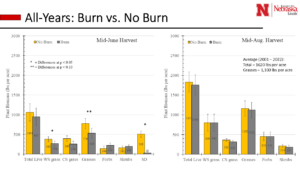
If prescribed fire is to be incorporated into Sandhills grazing systems, vegetation responses to fire in different contexts is paramount. Four years of aboveground plant biomass data at peak C3 (June) and peak C4 (August) plant growth show few differences between burned and unburned portions of the landscape. In other words, we did not observe substantial effects of prescribed fire on plant production. In June and August of 2022-2025, biomass of various plant functional groups was collected in the burned pastures and compared to BBR’s long-term grazing systems data, which contains plant biomass production at the ranch for over 20 years. No differences in the total biomass produced from burned or unburned pastures were found. However, one anticipated difference was detected in the amount of standing dead and litter material. Unsurprisingly, this dry plant matter quickly combusts during a prescribed fire and was significantly lower in burned pastures. In 2023, an additional difference was detected in the production of C3 grasses (cool season). This likely resulted from the timing of the burn, which did not occur until early May as dry and windy conditions persisted throughout the state in March and April. While weather conditions will vary production throughout a given growing season, these two years of data suggest that burning and grazing can occur in the same season with minimal effects on the total plant biomass production.

Forage quality
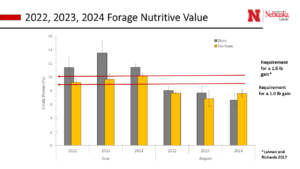
The fact that total biomass production remained consistent across both burned and unburned pastures at Barta Brothers Ranch does not explain why cattle in the patch-burn grazing system exhibited higher average daily gains (ADG) than animals in a traditional four-pasture deferred rotation. To better understand the nutritional quality of plant biomass, forage quality test were completed in each year. CAM's working hypothesis, that cattle are attracted to graze nutritious regrowth of grasses and forbs following fire, aligns with previous patch-burn grazing research. CAM's forage analysis of crude protein at Barta Brothers Ranch in June of 2022, 2023, and 2024 (1 - 3 months post-burn) found crude protein levels ranging from 11 - 14% in the patch-burn system, compared to a range of 9 - 10% in the deferred rotational system. For context, it is suggested that approximately 9% crude protein is required in forage to achieve a 1.0 lb. ADG, at just over 10% the ADG rises to 1.5lbs. However, when sampled again in August of the 2022, 2023, and 2024 grazing seasons, there were no differences in crude protein between burned and unburned pastures, with each around 7-8%.
Livestock behavior
To quantify the degree to which cattle were attracted to burned areas, we deployed GPS tracking collars on 5-8 animals each year to evaluate shifts in cattle grazing behavior (i.e., grazing and resting times) and grazing distribution (i.e., where animals are grazing) in the patch-burn grazing system study pastures. Results largely align with previous patch-burn grazing research, suggesting cattle are attracted to the flushes of new post-fire growth. For example, in 2022 cattle in the patch burn system were 1.5 – 2.0 times as likely to occupy burned patches compared to the unburned patches. This pattern did not hold in 2023, likely due to the timing of the prescribed burn in mid-May and resulting low intensity and patchy fire, but was again apparent in 2024. Across the three study years, cattle tended to select for burned patches (i.e., prefer them) during the year in which they were burned, select against burned patches (i.e., avoid them) the year after they were burned, and neither prefer or avoid them two years after they were burned. Within individual grazing seasons, the strength of cattle selection of burned patches decreased over time, with an estimated transition from preference to avoidance of burned patches 76 days post-turnout.

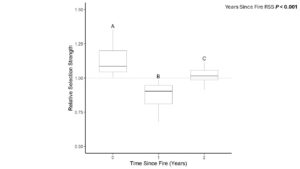
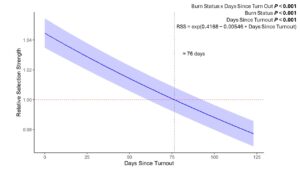
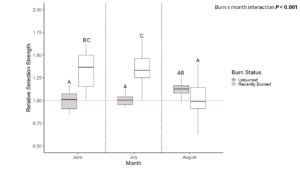
We found that prescribed fire effects cattle distributions in relation to topography. Specifically, with classification of all portions of the landscape as lowlands, open slopes, or uplands, we found that cattle are more likely to use uplands and open slopes in burned than unburned areas.
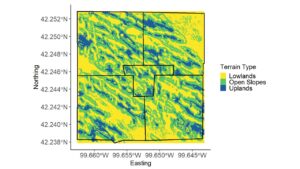
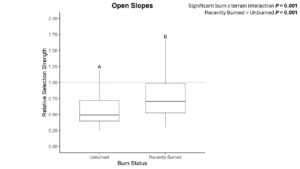
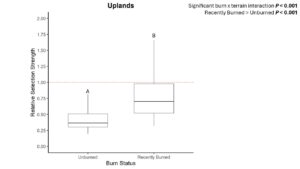
Livestock performance

Spayed yearling heifers were weighed three times during the year, pre-turnout in May, mid-season in July, and at pull-off in late September of the 2022-2024 grazing seasons. As a control, heifers in the burned/grazed pastures (pastures N-5 through N-8) were compared to other spayed heifers stocked at a similar rate in a standard four-pasture deferred rotation on the ranch. At the end of the grazing season in 2022, cattle in the patch-burn system were 24% (43 lbs.) heavier than those in the standard deferred system. In 2023, the cattle were 31% (36 lbs.) heavier in the patch-burn system, and in 2024, they were 26% (31 lbs.) heavier. In both years, average daily gains were not consistent throughout the season. In 2022, the cattle tended to gain more weight in June and July but later tracked closely with gains of the animals in the standard deferred rotation. In 2023, average daily gains held throughout the growing season, and in 2024, cattle in the patch-burn system outgained at the end of the growing season. At the sale barn, the greater gains of cattle in the patch-burn system yielded $86.96 more per head in 2022, $138.98 per head in 2023, and $74.90 more per head in 2024. In 2025, under the early stock substitution due to the inability to use prescribed fire, average daily grains in the patch-burn system were 22% greater and brought an average of $118 per head then the deferred rotational system. This provides evidence that in addition to the direct effects of the burn, cattle may be responding positively to the season-long continuous grazing in the patch-burn system.
Soil erosion
Originally formed by windblown sands, soils, and dust, Nebraska’s Sandhills are vulnerable to erosion by their very design. A key stakeholder concern is that by using prescribed fire, an unacceptable amount of risk is created if high winds or dry conditions trigger dune shifts. To monitor this effect, erosion measurements were taken at both burned and unburned pastures before and after the grazing season. On average, the burned/grazed pastures lost .881 cm of soil while the unburned/grazed lost .631 cm. While there was technically more erosion in the burned pasture, these amounts are negligible. This finding aligns with previous research performed in the Sandhills that found 4-5 years of repeated vegetation suppression was required before significant movement of soil occurred. Analysis of additional erosion data from 2024 - 2025 is ongoing.
Soil health
In grassland systems, plant productivity is highly dependent on the availability of nutrients in the soil’s profile. To further document the effects of utilizing prescribed fire, periodic measurements of soil properties such as organic matter, pH, and soil nutrient levels were taken before and after prescribed burning, followed then by monthly sampling through the remainder of the grazing season. These results showed no significant long-term changes in pH levels among burned and unburned pastures; however, there was an expected increase in both pastures one month after the burn (attributed to ash deposition in the pastures). No significant changes in soil organic matter nor any significant biological changes in the soil’s ability to exchange nutrients were detected. Of the major nutrients sampled, nitrate, potassium, and sodium had significant increases following the burn. However, as grazing was introduced, these levels ultimately returned to levels found in the adjacent unburned pastures. These results help support the notion that low-intensity prescribed burning can occur without irrevocably altering the soil’s organic matter, nutrient levels, or production capacity. Analysis of additional soil health data from 2024 - 2025, including carbon fractionation analysis, is ongoing.
Grassland bird diversity
Bird communities are often used as a bellwether of ecosystem health. To further understand how burning affects ecological communities and function, bird species were monitored during the nesting season (May – July) in both burned and unburned pastures in 2022 and 2023. A total of 41 avian species were identified with grasshopper sparrows, western meadowlarks, brown-headed cowbirds, and red-winged blackbirds accounting for 72% of all observations. Findings to date offer evidence that patch-burn grazing has positive effects on grassland birds at the landscape scale (across four-pasture system) by creating a wider array of habitat types. Analysis of additional avian point count data from 2024 - 2025 is ongoing.
Remote sensing and landcover

Field and remotely sensed observations were taken at Barta Brothers Ranch throughout the 2022 (one flight), 2023 (one flight), and 2024 (two flights) grazing seasons. Field sampling was carried out across multiple dune complexes and dune positions in pastures within the patch-burn grazing system and deferred rotational grazing system, and a neutral site formerly used to study biocomplexity in the system (2022 only). The goal of this ongoing research is to explore relationships between field-based vegetation diversity and remotely sensed spectral diversity, as mediated by topography and rangeland management.
In 2022, researchers detected an increase in the burned treatment's reflectance, likely arising from increased albedo affecting the surface energy balance. This team also found decreases in key energy absorption bands, likely resulting from the loss of standing biomass. These two observations may explain a possible surface cooling effect resulting from the use of prescribed fire. Plant species data was collected in 1-m2 quadrats of two dune complexes through Catherine Chan's Ph.D. research.
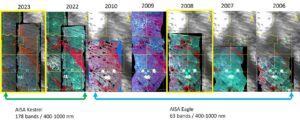
Comparisons of historical (2006 - 2010) and contemporary (2022 - 2024) hyperspectral flight data is underway. Images from 2006 to 2010 were collected for a grassland destabilization project (these treated areas can be seen in white dots which are more evident in the older images) while 2022, 2023, and 2024 flights were planned to cover a larger area, including CAM fire and grazing treatments. Imagery outlined in yellow (2008 and 2023) had associated ground sampled plant species and hyperspectral data collected along transects on different dune topographic positions (dune top, interdunal north slope, and south slope) in the same summer.
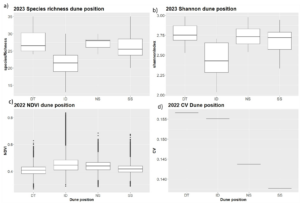
Preliminary results from these studies are shown in boxplots of a) species richness and b) Shannon diversity index derived from transect-level plant species data collected in 2023 along transects at four dune topographic positions (dune top [DT], interdunal [ID], north slope [NS], and south slope [SS]) and c) normalized difference vegetation index (NDVI) and d) spectral diversity (coefficient of variation-CV) derived from the 2022 imagery in Pastures N2 – N8.
From the plots, higher biodiversity may be associated with lower NDVI (greenness), potentially from variation of plant types rather than homogenous green vegetation. Panel d suggests higher variability of spectra for dune tops and interdunes possibly from high variation related to vegetation species, ground types (vegetation, soil, sand), or among transects in different complexes. Continuing analysis of relationships among field-based vegetation diversity, remotely sensed spectral diversity, topographic variation, and rangeland management is ongoing through Catherine Chan's dissertation research.
Hannah Allen's M.S. research includes testing the utility of Canopeo--a freely available smartphone app--for in-field biomass estimation, based on the proportion of green pixels in the cell phone image. She found a strong relationship between the proportion of green pixels in the image and total biomass, with month (June or August sampling) being an important driver of variability in predictions.
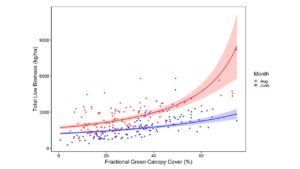
Ecosystem restoration and recovery
Following removal (i.e., mulching) of mature eastern redcedar stands in October 2024, preliminary results related to ecosystem recovery indicate high variability in species composition among the mulched plots and high proportions of annual plant species, compared to reference grassland sites. Results will contribute to understanding of the tradeoffs associated with eastern redcedar windbreak establishment, management, and removal in grassland landscapes.
Social learning
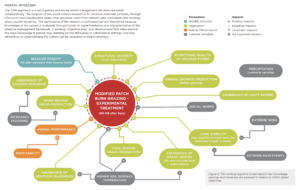
The CAM approach is a participatory process by which management decisions are made collaboratively. The purpose of this social science research is to chronicle exercises, primarily through a focus on how stakeholders make initial decisions, learn from relevant data, and adapt their thinking about system dynamics. In 2022, a working “cognitive map” was developed to explore the ways knowledge is gained, how learning can be stimulated in collaborative settings, and how differences in understanding the system can be navigated to build consensus. This working model will be revisited with the CAM stakeholders following the 2024 growing season.
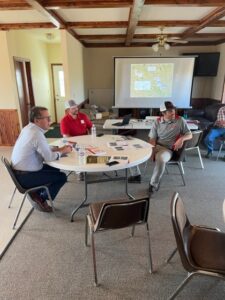
This project addressed contemporary challenges in rangeland management through collaborative adaptive management (CAM) at the University of Nebraska-Lincoln's Barta Brothers Ranch. Through this process, stakeholders, including local ranchers, articulated challenges, questions, and uncertainties related to the spread of invasive species--especially encroachment by eastern redcedar--landscape heterogeneity, and livestock productivity and operational profitability. The stakeholder team then designed an experiment for strategically addressing management uncertainties and implemented it at Barta Brothers Ranch, insulating producers from the risks of experimentation on their own operations. The experiment involved monitoring and comparison of the ecological, animal performance and behavior, and economic outcomes of a patch-burn grazing system and a deferred rotational grazing system from 2022 - 2025. During this time, the stakeholder team met at least semi-annually at the ranch for field tours, to receive updates on and discuss monitoring results, and to make decisions related to management experiments.
Project results addressed a number of stakeholder-articulated management uncertainties. A key livestock performance result was that that cattle in the patch-burn system had better performance than cattle in the deferred rotational grazing system in each of the four studies years, with 22-31% greater average daily gains that translated into $86-$138 more per head at the sale barn. In terms of livestock movement, cattle selected recently burned patches over unburned patches early in the grazing season. As the grazing season progressed, cattle increasingly selected the unburned pastures, until there was no effect of burning on cattle selection by August of each year. Also, within burned pastures, cattle were more likely to use open slopes and uplands than in unburned pastures. In regard to reducing the encroachment of eastern redcedar, we found 72% overall eastern redcedar mortality across 1,160 trees in a pasture within the patch-burn grazing system, with greater counts and mortality rates of smaller trees. We also found that by August of each year, there were no effects of prescribed fire on vegetation productivity. We found no substantial differences in erosion between burned and unburned pastures, with both experiencing relatively small amounts of erosion/deposition (1 – 3 cm) and neither demonstrating an effect across entire pastures in the year of treatment or subsequent years.
Stakeholder learning and perceptions of the CAM process were monitored through surveys, mental modeling activities, and facilitated discussions. At the December 2025 meeting, stakeholders articulated four forms of knowledge related to the CAM process: 1) CAM-reinforced knowledge--things they knew prior to CAM and still know; 2) CAM-amended knowledge--things they thought they knew and updated or adjusted following CAM; 3) CAM-generated knowledge--things they did not know prior to CAM; and 4) CAM-attainable knowledge--new or remaining questions that could be addressed via CAM moving forward. Broadly, these learning outcomes support the utility of CAM as an ongoing, iterative process for informing decision-making amidst uncertainty and change.
Education
The CAM Project utilizes a tiered-approach to learning and education. Through the CAM framework, we emphasize collaboration in our structured decision-making process to guide management of the experiment. This setting allows for group participation, enhanced learning outcomes through cognitive modeling, and provides a rich environment for the co-production of science. We also look to expertise from Nebraska's Extension Educators who possess a breadth and depth of practical experience alongside their innovative approach to collaboration and education in the agricultural community. Lastly, we rely on the outreach efforts from the entire University research team as individual members conduct field tours, consultations, presentations, author media articles, and host training and networking opportunities throughout the year. This diversified approach allows the CAM Project to have immediate relevance within the Sandhills region (focal point of study), but it also allows CAM to communicate and coordinate with stakeholders statewide on the implications of the CAM Project.
Project Activities
Educational & Outreach Activities
Participation summary:
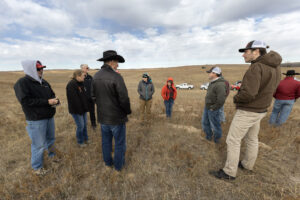
The first four years of the CAM Project at Barta Brothers Ranch were active with education and outreach. To summarize, these included regular CAM project team meetings, articles in University newsletters and regional media outlets, the establishment of a web presence for the Barta Brothers Ranch and the CAM Project, presentations to audiences of ranchers, natural resource managers, and researchers, and several on-site field exercises and tours. Consultations are being held with neighboring ranches to discuss CAM's implications and proactively manage eastern redcedar across the landscape. Researchers are also sharing preliminary findings with colleagues at national conferences, helping bolster the data collection and analysis efforts of the CAM Project Team. Cumulatively, we estimate that over 2,700 individuals engaged in grassland management or education have received information about the CAM Project at Barta Brothers Ranch.
CAM Project Team Meetings
The CAM Project Team (ranchers, natural resource managers, and researchers) began a regular cadence of meetings at the ranch (at least two times per year). These meetings are a steady stream of CAM project updates, research design or analysis, and the selection and weighting of indicators to evaluate the outcomes. These team meetings also combine field tours to the pastures to inspect and discuss conditions firsthand. These meetings and associated exercises are critical to the structured decision-making process established in an adaptive management approach. These meetings result in approximately 600 hours of combined continuing education for the CAM Project Team.
Education

The University research team was active with both its education and outreach in years 1 - 4 of the CAM Project. Presentations were delivered to the America's Grassland Conference, Nebraska Grazing Conference, the Society of Range Management (national and Nebraska chapters), the Nebraska Cattlemen Association, Nebraska Grazing Lands Coalition, a University of Nebraska Agricultural Resilience Forum, Center for Grassland Studies Fall Seminar Series, Nebraska's Sustainable Agriculture Society annual meeting, The Wildlife Society International Meeting, The American Geophysical Union National Meeting, The Nebraska Prescribed Fire Conference, and the Nebraska Natural Legacy Conference.
These efforts were matched with tours, consultations, and other educational activities occurring in the Sandhills region. For example, CAM researchers led a group of area ranchers on a tour of the modified patch-burn grazing system at Barta Brothers Ranch at least twice per year. CAM researchers consulted with several ranching families on the successful use of prescribed burning in their management plan. CAM researchers also led an educational session with Nebraska's Extension Educators on the CAM project's objectives and how to get involved. A highlight in 2023 was the first open house held at Barta Brothers Ranch in over ten years. This event drew in 60 attendees, many of them neighboring ranchers.
Outreach

The establishment and revision of University webpages were important contributions in heightening the awareness of the CAM Project in Nebraska and beyond. This included new webpages for the Center for Resilience and an associated page about CAM as well as revisions to the Nebraska Extension website. CAM researchers produced ten web-based articles, three articles for University newsletters, one short-form podcast for statewide media distribution, and a nationally syndicated television interview with RFD-Tv. The team is currently developing a second standalone publication summarizing the CAM Project and years 1 - 4 results.

Learning Outcomes
- adaptive management
- patch burn grazing system
- ecosystem services
- management of tradeoffs
- woody encroachment management